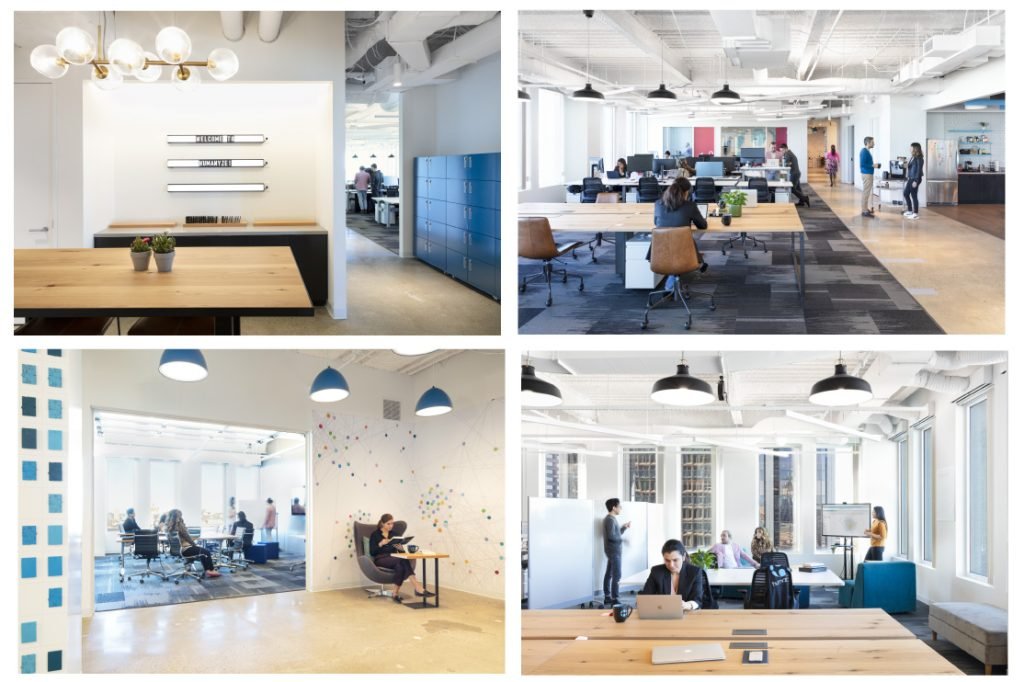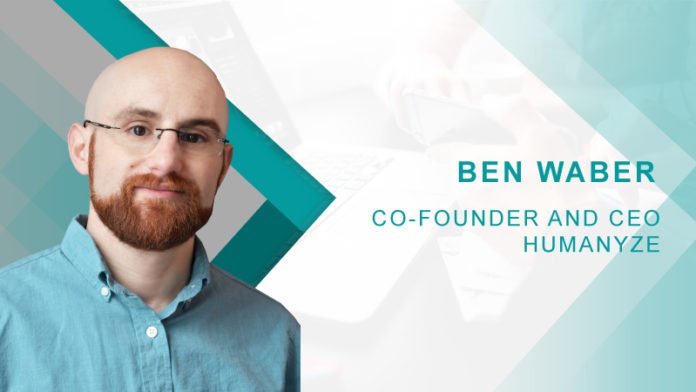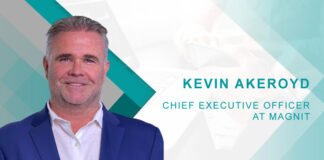1. Tell us about your role in Humanyze?
My name is Ben Waber and I am the CEO and one of the co-founders
2. Can you tell us about your journey into this market?
It goes back to the founders, Taemie, Daniel, and I, starting our PhDs over at the MIT Media Lab. At the time, we were trying to use sensors and data on interactions to predict who would win a salary negotiation or who would end up on a date. Fairly early on, people at the Business school saw that there was an application of that technology in the workplace. A couple of months into our PhD we had the opportunity to go to a large bank in Germany and analyze data on how people interact in the work setting—and with it we were able to predict outcomes in the company based on this interaction data. We ended up writing a paper on the results and sent it to the executive team at the bank. They found the information very useful and decided to reorganize the entire company based on the findings. Throughout this process, we realized that companies don’t fundamentally understand how teams communicate with each other or how often, and that people make multi-billion dollar decisions without understanding all of this. To us, it seemed like something worth changing.
3. How do you think technology is changing the HR Sector?
From a data perspective, I think technology is giving HR the opportunity to bifurcate the strategic and administrative parts of what HR is. They are both important, but most organizations have conflated the two. Part of the administrative functions of HR are for people to get paid, evaluated, for training programs to be implemented but all of this is very different from trying to experiment with different organizational structures, processes, etc. Both parts of HR need different tools and internal processes.
Technology is making it easier to get administrative processes to become smoother and more streamlined which means you now have more time to focus on the strategic things.
Currently, the people side of work is so unoptimized compared to the other side of the HR organization—however tools do exist.
4. How has data-driven approach helped in delivering better employee experience?
The challenge is that the current process of evaluating the employee experience is slow, through surveys and the like, and it’s something in which ROI is hard to quantify. If instead we can quantitively say what the impact of improving the employee experience has on the business goals or earnings and point to outcomes it will be easier to have a discussion. In the long term there are a lot of meaningful things you can do with the data but in the near term it’s more about justifying why making these investments make sense.
5. Why has employee engagement become a hot topic in the industry?
The people side of organizations have been wanting to have conversation around employee engagement and it’s link to performance and business goals of an organization. Without metrics they can’t do that and are pigeonholed into the administrative side of things. Employee engagement is something that people now feel is important because it’s harder to compete for talent, it’s now broadly subjectively recognized that better employee engagement leads to better outcomes. The challenge is now to get to the next step, the risk is that without more technologies there won’t be a lasting change until we embrace the technologies that can help us make those connections between the people side of things/metrics, and the goals of a company. Employee engagement does matter and the biggest product that organizations have is the people that work there and not actually what they make.
6. How do you think improving workplace can help in employee satisfaction?
Work is where people spend the majority of their waking hours. The reality is that the cheapest thing to do is to have everyone work from home, but if you do that you are throwing out the strongest management tool you have: the idea that if people sit next to each other they communicate with each other a lot more.
It’s not impossible but it is very hard to get people to communicate and interact with each other through more regimented implementations like scheduling meetings between people or using IT/HR tools that help make this more intentional. But the truth is, those means are not that effective. However, by better planning your workplace you can influence the way people bump into others who they don’t normally talk to thus improving employee engagement and satisfaction.
7. What differentiates your people analytics platform from others in the market?
Humanyze was built on uncovering work patters through a scientific approach. We are not interested in making up metrics or benchmarks, rather, we want to give companies real, concrete, validated information they can use. There are also more technical things like our ability to integrate data from various different sources which is important. But we built our product to be useful and right, not just for show. This is important, we are talking about company decisions that affect individual employees. If you make decisions using incomplete information or wrong metrics you can make really big mistakes that can affect the livelihood and experience of hundreds and thousands of people.
8. What advice would you like to give to the upcoming HRTech Start Ups?
It is important to understand the difference between the strategic and administration sides of HR. At the end it all comes down to budgets, learning how to navigate this is important, the administrative side has most of it and you can bring lots of value to it, however there is also the strategic side where future growth is gonna be. This is especially true with large organizations. If you are working with SMBs it’s a different discussion, smaller businesses have real constraints, they are most likely choosing between your product and hiring another employee which is an extra 10% of their workforce. You need to make sure you are solving a real need and understand that it will be harder for them to focus on the strategic stuff.
9. What work related hack do you follow to enjoy maximum productivity?
Changing where you sit or slight aspects of the workplace is important for improving your productivity. But the important thing is not your productivity, rather, it’s improving the productivity of the people you work with. It doesn’t matter what your role is—the truth is that individuals can only improve their productivity by a certain percent, there is a cap. However, affecting other people, is much more important and figuring out how you can help those people is where your focus should be.
10. How do you prepare for an AI-centric World?
AI is a tool. It’s important to realize that the reason that AI is getting more predictive over time is that we have more data and we need to understand what these tools are good for and what they don’t do very well. They are not magical algorithms, they are simple statistical tools with fun names like neural networks or vector machines, but fundamentally what they do is help you make decisions based on the mathematical probability of the data being fed. If you understand how it works, then you will know how to use it. You have to ask yourself what AI tools make since for your business and understand that AI is just like any other tool–just a lot more predictive.
11. What are the major developments you are planning, in recent times?
I am focusing on connecting with people and developing relationships but also setting time aside to focus on reading more research. I really like to have a deep understanding of people analytics in general. I have always skimmed through abstracts of the latest papers, but since I finished my PhD I haven’t really taken the time to sit down and read full papers to get a deep understanding of the topics they cover. I feel that reading a full research paper gives you a better perspective and helps you see what new developments are coming.
12. Can you tell us about your team and how it supports you?
My team and I have now been working together for around 13 years. We are at the point where we recognize what each others strengths and weaknesses are. We can talk to each other about anything and we can support each other if we ever need someone to cover or help out. We are very supportive when it comes to family time off or when we need to step in and support each other during our work.
13. Which Book are you reading these days?
I try to mix up, I typically read both a sci-fi book and a non-fiction at the same time. The last sci-fi book I enjoyed was “Foundryside,” which is a world with something akin to IoT but that shows itself as magic, it’s an interesting concept. For non-fiction, I recently finished reading “Factory Girls,” it follows factory working girls in china over the course of several years, it was a very interesting read.
14. Can you give us a glance of the applications you use on your phone?
I currently use “Line” quite a bit, which is a chat app, very popular in asian countries except for China. I also have the standard ones like Slack, Giphy, PokemonGo, but I don’t think I have any earth shattering ones. I have airline apps because I travel a lot, kindle, and audible are other apps I use regularly.


Ben Waber Co-Founder and CEO, Humanyze
Dr. Ben Waber is the CEO and co-founder of Humanyze. He is a visiting scientist at the MIT Media Lab, previously worked as a senior researcher at Harvard Business School, and received his Ph.D. from MIT for his work with Alex “Sandy” Pentland’s Human Dynamics group. Waber’s work has been featured in major media outlets such as Wired, The Economist, and NPR. He has consulted for industry leaders such as LG, McKinsey & Company, and Gartner on technology trends, social networks, and organizational design. His book, People Analytics, was published by the Financial Times Press in 2013.












